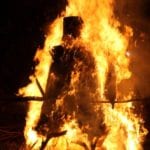 Religion
Religion  Religion
Religion  Facts
Facts 10 Things You Never Knew about the History of Gambling
 Weird Stuff
Weird Stuff 10 Cool and Creepy Facts about Collecting Tears
 Humans
Humans The Ten Most Lethal Gunslingers of the Old West
 Misconceptions
Misconceptions 10 Phony Myths and Urban Legends That Just Won’t Die
 History
History 10 Amazing Roman Epitaphs
 Weird Stuff
Weird Stuff 10 Niche Subcultures That Are More Popular Than You Might Think
 Mysteries
Mysteries 10 Tragic Disappearances and Deaths in Joshua Tree National Park
 History
History 10 Ways Childhood Really Sucked in the Old West
 Music
Music 10 Name Origins of Famous Bands from the 1990s
 Religion
Religion 10 Mind-Blowing Claims and Messages Hidden in the Bible Code
 Facts
Facts 10 Things You Never Knew about the History of Gambling
 Weird Stuff
Weird Stuff 10 Cool and Creepy Facts about Collecting Tears
Who's Behind Listverse?

Jamie Frater
Head Editor
Jamie founded Listverse due to an insatiable desire to share fascinating, obscure, and bizarre facts. He has been a guest speaker on numerous national radio and television stations and is a five time published author.
More About Us Humans
Humans The Ten Most Lethal Gunslingers of the Old West
 Misconceptions
Misconceptions 10 Phony Myths and Urban Legends That Just Won’t Die
 History
History 10 Amazing Roman Epitaphs
 Weird Stuff
Weird Stuff 10 Niche Subcultures That Are More Popular Than You Might Think
 Mysteries
Mysteries 10 Tragic Disappearances and Deaths in Joshua Tree National Park
 History
History 10 Ways Childhood Really Sucked in the Old West
 Music
Music 10 Name Origins of Famous Bands from the 1990s
10 Amazing Moments In Espionage
As long as there have been people, there have been groups. As long as there have been groups, there have been secrets. As long as there have been secrets, there have been spies. And as long as there have been spies, there have been amazing tales of derring-do and courage and stupidity that mere mortals like us can only look upon in wonder. Tales like . . .
10 The Roman Slapstick Show

In 204 B.C., the Romans sent an expeditionary force of 20,000 men led by General Publius Cornelius “Africanus” Scipio to North Africa. However, they were soon confronted with an army of 90,000 Carthaginians, all of whom were eager to stab some Roman faces. Faced with this, Africanus quickly established a fort and set about planning to destroy his new enemy.
The Carthaginian force was divided between two camps. In order to gather information about the layout of these camps, Africanus pretended to negotiate with the Carthaginians and so sent envoys to each camp. Each envoy was accompanied by a group of servants who were really Roman centurions in disguise. On one such visit, the Romans “accidentally” released a horse from their convoy, which proceeded to run amok through the enemy camp. As the Carthaginians stood around laughing at the ineptitude of the “servants” feebly chasing the horse, the disguised centurions were actually taking careful mental notes about the layout and construction of the camp.
These spying missions revealed that the buildings of the camps were constructed using wood and reeds—insanely flammable materials. One night, Africanus launched a surprise attack and burned each camp to the ground, ending the conflict and killing over 40,000 enemies with no tricks more advanced than those seen in a Charlie Chaplin film.
9 Eli Cohen
Trees In Golan Heights

In 1957, Eli Cohen was recruited by the Israeli spying agency Mossad to infiltrate the Syrian government and gather intelligence about the country’s defenses and military, lest any conflict break out in the region.
After several years training and building up his cover story as a businessman, he moved to Damascus in 1962, where he immediately set about ingratiating himself with influential politicians, diplomats, and military officials. At his home, he held wild parties where girls, drink, and—most importantly—sensitive government information flowed freely. Indeed, Cohen’s infiltration was such a success that it is rumored that, after the election of Amin al-Hafiz to the post of Syrian Prime Minister, Eli was considered as a strong contender for the role of Deputy Minister of Defense.
Thanks to his close relationship with military officials, Cohen was regularly taken on tours of fortifications. In his most famous exploit, Cohen was sent on a tour of Syrian army facilities at the Golan Heights. Pretending to be appalled by the fact that the soldiers stationed there were left in the sun for hours at a time, Cohen ordered trees to be planted at each position, under the guise of providing the soldiers with necessary shade from the heat, as well to camouflage the positions from the Israelis. However, in reality, the trees also served as markers for any potential bombing campaign by the Israeli Army. Indeed, after the outbreak of the Six Day War, by using the trees to indicate where soldiers were positioned, the Israeli Defense Forces were able to use these trees to conquer the Golan Heights in less than two days.
Sadly, Cohen wasn’t able to see his crowning achievement. In January 1965, Cohen was caught in his apartment transmitting sensitive information back to Israel. On May 18, despite pleas for clemency from Israel, Cohen’s wife, and several countries, Eli was executed.
8 Sarah Edmonds Infiltrated The Confederate Army (Dressed As A Black Slave)

If her choice of favorite childhood book was anything to go by, Canadian-born Sarah Edmonds was always destined to raise a special type of hell. The book in question was Fanny Campbell, the Female Pirate Captain; it told the tale of Fanny Campbell, a woman who disguised herself as a man and became one of the most feared pirates of the day. Edmonds was hooked and vowed to live a life as adventurous as Fanny’s. When the American Civil War came knocking, she got her chance.
After disguising herself as a man with the moniker of Franklin Flint Thompson, she enrolled into the Union Army where she first served as a field nurse. Following the execution of a spy that was placed into the Confederacy, she quickly took his place and successfully infiltrated several Confederate camps using a variety of methods. In one instance, she dyed her skin black using silver nitrate and played the role of “Cuff,” a migrant slave. She was quickly assigned to work on the defenses being built to repel the Union. Two days later, she absconded along with vital information about the Confederacy’s weapons, morale, and gun emplacement positions.
After several similar missions (including one where she dressed herself as an Irish peddler woman), she contracted malaria. As she couldn’t seek treatment from the Army, lest they discover her true sex, she deserted and was treated as a civilian woman. After the end of the war, she wrote her memoirs entitled Nurse and Spy in the Union Army and in 1884, in recognition of her work, was granted an honorable discharge from the army along with a veteran’s pension.
7 Indian Spies Scared Enemies By Pretending To Be Gods And Demons

In Ancient India, it was commonplace for kings to visit temples and demonstrate their close relationship with the gods by conversing with them. Hidden spies would pretend to be the voice of the god and drain the morale of the king (and assembled crowds) by smack-talking about them. On top of this, blood would be made to pour from statues and tunnels would be secretly dug, so that spies could “miraculously” appear in the center of sacred fires and scare anyone in the vicinity.
If the temple had a pool, the spies would wait underwater (using snorkels made of animal intestines), and—when the moment was right—burst out, all while breathing smoke (which came from the mouths of their costumes) and being on fire, thanks to special burning oils. And if that wasn’t terrifying enough for the poor king, the spies would be instructed to do this while sharpening swords and other weaponry.
In addition, spies would stalk the grounds outside enemy cities while wearing bear skins and making noises akin to antelopes and jackals with smoke pour from their mouths. Should any citizen be brave enough to approach the “god,” they were swiftly beaten to death with a bar, in order to make it look like they’d been killed by a demon.
6 Sun Tzu Tricked His Own Spies To Misinform The Enemy

One of the first historical figures to use spying in any significant military capacity was Sun Tzu, the master of warfare responsible for the classic The Art of War. In this, he espoused that spies and espionage were necessary elements of any army, and that going into battle without utilizing spies was a surefire way to lose.
One of Tzu’s favorite tactics, however, was to use “doomed spies.” In an act of extreme evilness, he would supply his spies with false information about his army and then send them off into the battlefield to spy on the enemy; when they were in position, he then arranged for them to be captured by the enemy. During torture, the spy would divulge the information, believing it to be accurate. The enemy would then form a battle plan based on this information, not knowing that Tzu was actually using completely different tactics. You can probably guess what happened to the “doomed spies” at the enemy’s hands once they’d learned that they’d been deceived.
5 Monks Smuggled Silkworms Across Asia In Hollowed-Out Walking Canes

Before the sixth century, the production and trading of silk was controlled by two
monopolies. One was held by China, who possessed the only way of breeding the silkworms necessary to manufacture the silk. The other was held by Persia, who controlled the only trade route that passed through Asia to Europe.
In A.D. 552, two monks volunteered to travel to China and smuggle back silkworm eggs and larvae to Justinian I, the Byzantine Emperor. However, as silkworms are extremely fragile creatures which needed to be kept at a constant low temperature, the monks had to smuggle the silkworms back inside hollowed-out walking canes which also allowed them to escape with the creatures unhindered. Additionally, in order to feed the silkworms, the monks also had to carry potted mulberry shrubs with them, which they would have had to water with their own drinking water if required.
This adventure took two years, after which the Byzantines were able to create production bases around the country, which broke the previously lucrative monopolies of China and Persia.
4 The CIA Climbed The Himalayas And Lost A Radioactive Spying Machine

Not all of the craziest stories from the world of espionage have a happy ending. There’s no better example of this than the time that the CIA tried to install a plutonium-powered surveillance device on the top of a mountain in the Himalayas and lost it.
It was 1965. The Cold War was in full swing and, not far behind it, the Vietnam War. Even worse, intelligence reports were suggesting that the Chinese had developed a long-range nuclear weapon, a major problem seeing as the Communist Chinese weren’t exactly on speaking terms with the nation that epitomized capitalism. In order to assess the capabilities of these supposed nuclear weapons, the Americans needed to spy on Chinese nuclear tests, which took place within a top-secret facility in the Chinese region of the Himalayas. But how could they pull it off?
The answer came in the form of Nandi Devi, a 7,600-kilometer (25,000 ft) mountain in the Himalayas, and one well within the confines of India, an ally to the USA. The CIA recruited a team of mountaineers who had successfully scaled the mountain several years beforehand and set them on their task. They were to climb to the summit of Nandi Devi and assemble a piece of apparatus which would monitor any nuclear tests that took place within the region. This equipment—known as a SNAP unit (Systems for Nuclear Auxiliary Power)—was powered by plutonium. Later that year, the climb took place. But, before reaching the summit, problems soon emerged with the oxygen supplies, which were then complicated by the arrival of severe snowfall. The expedition was abandoned; however, to save the team the trouble of transporting the SNAP unit down the mountain again, they stowed it inside a crevice and left it until spring of the following year, when they would return, retrieve it, and finish the job.
You can probably guess what happened next. In 1966, the team returned as promised, but the device was gone with no trace. Searches of the mountain for radiation yielded no results, while the Indians denied stealing it for the plutonium within. It was eventually concluded that a landslide had buried the unit under tons of snow, a resting place where the device still lies today.
3 Cats Found Hidden Soviet Bug In Embassy Walls

During the Cold War, the USSR and USA spied on everyone and everything. And, yes, when we say “everyone,” we mean everyone. Even the Dutch, the least harmful nationality in Europe (second only to Switzerland), were bugged by the Soviets in the early 1960s. Luckily, they caught out in the strangest way possible: by cats.
At the time of the bugs’ discovery, the ambassador Henri Helb was working in his office one day in 1961 when suddenly his two pet Siamese cats, which were previously asleep in the room, awoke with a start and started to paw at the wall. At first, Helb imagined that the cats had heard a mouse in the walls. However, he suddenly realized that what they’d heard was far more sinister. Using their super-hearing, the cats had caught the sound of a microphone, hidden deep within the wall, being switched on via radio waves.
With this discovery, you might imagine that the microphone was removed immediately. Not so. Instead, the embassy staff began misleading the Soviets by having “top-secret” meetings near the microphone. On another occasion, the staff complained about how repair work on their broken sewers had been delayed yet again; coincidentally, a team of sewer engineers arrived the next morning to fix them. After a length of time, the embassy’s staff simply adapted to their presence and didn’t bother removing them. After all, they never knew when they might need some more repairs done.
2 The CIA’s Fake Movie

In 1979, a group of armed Iranians seized the US Embassy in Tehran, taking 52 people hostage and beginning a crisis that would last until 1981. Fortunately, in the chaos and confusion of the situation, one group of diplomats managed to escape capture. Trapped on the city’s hostile streets, they were eventually taken in by a group of Canadian diplomats who sheltered them from the government (who were conducting rigorous house-to-house searches, knowing that several individuals were unaccounted for).
Needing desperately to rescue these diplomats, the CIA started to draft plans for a mission into Iran. Obviously, the Iranians weren’t going to let them in easily, so they hit upon an ingenious plan: A group of agents would travel to Iran under the guise of scouting for a location to shoot a science-fiction movie called Argo. Knowing that the Iranians would investigate the filming company, the CIA spared no expense in making their alibi bulletproof. They produced fake film posters, held glitzy parties in LA nightclubs, set up a functioning production office, hired noted special effects and make-up artists as “staff,” and even handed out fake business cards throughout Tinseltown.
The Iranians fell for the ruse hook, line, and sinker. On arriving in the country, the CIA made contact with the diplomats and provided them with genuine Canadian passports in order to allow them to board a flight out of the country.
1 The USSR (Accidentally) Helped Build The SR-71 Blackbird

Without a shadow of a doubt, one of the greatest instruments ever built for spying was the SR-71 Blackbird. Serving with the US Air Force as a reconnaissance aircraft, in the 35 years that it was in service, none were ever shot down by the enemy. There are two reasons for this. Firstly, the plane was engineered in such a way that its radar signature was nearly invisible. Secondly, its massive turbojet engines ensured that if any enemy fighter or surface-to-air missiles tried to engage it, the pilot simply had to accelerate to the plane’s top speed of Mach 3 to escape, a speed well beyond the capabilities of any Soviet technology.
Building the plane, however, wasn’t easy. In order to ensure that the Blackbird could withstand the temperatures that would ensue after reaching its top speed, it was necessary to construct it from titanium. However, the only country in the world with a suitably large quantity of high quality was Russia.
To acquire the titanium, it was therefore necessary for the CIA to purchase huge quantities of the material using several dummy corporations, where it was then shipped back to the US in secret. It isn’t known whether the USSR ever realized that they’d accidentally helped to create the aircraft that would be invading their airspace for the next several decades. That is, unless the guy who brokered that deal is reading this, in which case, um, thanks.
For more from Adam, you can check out his website, One Word Louder, or follow him on Twitter.








